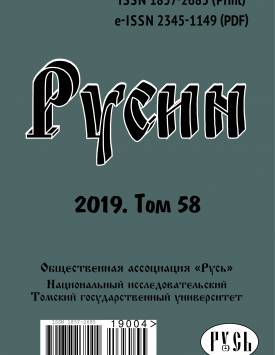Slav unity and Siberian society during the Civil War. 1918-1919
The idea of Slav unity started to develop towards the end of the First World War, when international relations were changing. The Slavs in Austro-Hungary, Russia, Ottoman Empire received freedom and founded their own states - Yugoslavia, Poland, and Czechoslovakia. Following that, representatives of the new states, public and political leaders became active in Siberia under the government of A.V. Kolchak. Some of them saw the future of the Slavs in their unity, renewed power, and geopolitical importance, expeceting that Russia would help unite and protect the Slavs. This mission of Russia was reiterated in speeches and interviews of the Slavs, White movement leaders, and Siberian public figures. Before the end of World War I in the autumn of 1918, the Slav representiatives and anti-Soviet powers united on the basis of the fight against Germany and Austria-Hungary, and later against the Bolsheviks, who “betrayed Slavic peoples and Russia” by concluding the Treaty of Brest-Litovsk. The Slavic states woke up to a new reality. In the post-war world, Siberia public and Siberian Slav organisations, such as The Slav Union and Slavic Brotherhood, thought the Slavs to be the creators of a new society based not on obedience but on equality and free choice. They spread the ideas of neo-Slavism, cooperation through trust, and development of relationships in culture (spreading knowledge about the Slav history, education, and life as such) and economy (including aspects of finance, trade, and production). Ideological foundation and political realisation of the strategy to achieve Slav unity were equally important for the resolution of current problems at the time and for the future.
Keywords
Siberia,
public leaders,
Civil War,
Slav unity,
White Guard governments,
гражданская война,
общественные лидеры,
Сибирь,
белогвардейские правительства,
славянское единствоAuthors
| Naumova Natalia I. | Tomsk State University | tomnin@yandex.ru |
Всего: 1
References
Славянское общество // Сибирский голос. Иркутск. 1918. 1 нояб. № 32. С. 4.
Суляк С.Г. Русинская идентичность (на примере участия галичан в гражданской войне) // Русин. 2015. № 42. С. 107-125. DOI: 10.17223/18572685/42/9
Суляк С.Г. «Свободное слово. Ежемесячный Карпато-русский журнал» как важный источник по истории Подкарпатской Руси межвоенного периода // Русин. 2019. № 57. С. 195-229. DOI: 10.17223/18572685/57/12
Серапионова Е.П. Карел Крамарж и Россия (1890-1937 годы). М.: Наука, 2006. 512 с.
Семипалатинский П. Несколько заметок о славянском сближении // Русская армия. Омск.1919. 9 марта. № 48. С. 2-3.
Ромашов Ю.В. Образ Южных славян и идея славянского единства в панславистских концепциях в России второй половины XIX - начала XX в.: автореф. дис. канд. ист. наук. Саратов, 2013. 20 с.
Приветствия Верховному правителю // Правительственный вестник. Омск.1919. 30 июля. № 197. С. 3.
Омск, 1 апреля // Русская армия. Омск.1919. 1 апр. № 67. С. 1-2.
Омск, 22 октября // Русская армия. Омск. 1919. 22 окт. № 228. С. 1.
Омск, 6 августа // Русская армия. Омск. 1919. 6 авг. № 167. С. 1.
Отовсюду (из газет) // Русская армия. Омск. 1919. 19 июня. № 127. С. 4.
Объединение славян // Сибирская жизнь. Томск. 1919. 27 февр. № 40. С. 2.
Объединение славянства // Сибирская жизнь. Томск. 1919. 18 окт. № 220. С. 2.
К годовщине освобождения Сибири от большевиков // Русская армия. Омск. 1919. 7 июня. № 118. С. 2-3.
Н. Среди славян // Русская армия. Омск. 1919. 25 марта. № 61. С. 3.
Жуковский В. Задачи общеславянской культурной работы // Наш путь. 1919. 22 (9) сент. № 2. С. 2.
Из особого Совещания при Министерстве иностранных дел // Русская армия. 1919. Омск. 1 февр. № 23. С. 3.
Григорьева А.А. Панславизм: идеология и политика (40-е годы XIX - начало XX вв.): автореф. дис. _ канд. ист. наук. Иркутск, 2010. 26 с.
Государственный архив Омской области. Ф. P-346. Оп. 1. Св. 15. Д. 480. Материалы о регистрации «Союза славянского».
Второй карпаторусский съезд // Карпаторусское слово. Омск. 1919. 4 мая. № 10. С. 1.
Второй карпаторусский съезд // Русская армия. Омск. 1919. 17 апреля. № 80. С. 3.
Верус. Вечер славянского единения // Правительственный вестник. 1919. 7 мая. № 129. С. 2.
Воззвание «Союза славянского» // Русская армия. Омск. 1919. 5 марта. № 44. С. 4.
Всероссийский национальный центр. М.: Российская политическая энциклопедия (РОССПЭН), 2001. 608 с.
Благодарность Верховному Правителю от Русского народного совета Прикарпатской Руси // Русская армия. Омск. 1919. 27 марта. № 63. С. 3.
В-в А. К славянскому единению // Русская армия. Омск. 1919. 13 июня. № 122. С. 2.
2 августа. Обращение к славянам // Дальневосточное обозрение. Владивосток. 1919. 2 авг. № 118. С. 2-3.

